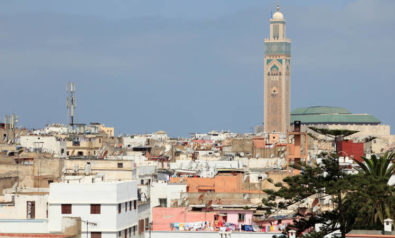China’s economic direction, with all its inequality and uncertainty, can be seen in one construction site in Beijiao.
William Blake once claimed to see a world in a grain of sand. With a slightly less ambitious mental leap, I reckon I can make a fist of seeing today’s China — with all of its aspirations and uncertainties — in the village of Beijiao in southern Guangdong Province.
A short walk from a Ramada Hotel that is seldom busy, a luxury apartment complex that is so empty it does not have its own garbage disposal system, and an American Chamber of Commerce Tower and Conference Centre is a construction site. The workers on the site and some of their families live in a shanty town made up of temporary shacks and shipping containers, as they build what will become the Beijiao International Finance Centre.
Unlike most employees at the nearby Tesco superstore, where slogans on the wall such as “local jobs for the local community” recall communist propaganda of years gone by, the construction workers are not local. They are among China’s 260 million migrant workers.
The Lives of Migrant Workers
When I walk up to a group of the migrant workers, middle-aged men playing cards at eight in the evening, I ask when the building will be finished. One answers, despite clearly being annoyed by the interruption: “Don’t know, several years from now it seems.”
Ah San, a younger worker at the construction site, does not join in the game of cards; he prefers to stay in the shipping container he is lucky enough to have to himself and listen to hardcore music. His neighbors are unlikely to ask him to turn it down. They managed to sleep through the recent storms that tore across Guangdong and start work at 7am, even though much of the site has been waterlogged.
Ah San and his colleagues only got one day off for the Tomb Sweeping Festival, so none could go back to their hometowns for the holiday. The situation of being separated from their extended families as they work and send money back to the hinterlands is one faced by migrant workers across the nation.
Local governments and businesses have introduced measures to help alleviate this problem. The often anti-establishment Guangzhou Daily reports that 3,000 migrant workers in neighboring Shenzhen are granted free travel home during the Spring Festival every year. But this is little more than a gesture. According to state media, 40% of migrant workers did not return home for the Spring Festival in 2014. China Daily reported in January that over 90% of migrant workers in local factory hub Dongguan who returned home for the festival would come back afterward.
… in China’s state media, migrant workers are largely portrayed as the pioneers who form the backbone of the country’s breakneck economic growth. In Western media, portrayals tend to focus on the hardship and exhausting working hours they face.
In Robert Putnam’s Bowling Alone, life satisfaction is best predicted not by wealth or health, but by the breadth and depth of one’s social relations. Putnam’s point, however, presents a problem for China’s migrant workers. Staff turnover in many jobs is so fast that workers at Shenzhen’s Foxconn plant report not knowing the names of their own roommates.
The Future They Are Building
In spite of this, being a migrant worker is probably the best bet for Ah San and his colleagues. Beijiao may be sparsely populated and underdeveloped, but it is undeniably growing. The town is part of Foshan City’s Shunde District, which was established in 1452 when Ming Dynasty rulers successfully suppressed a peasant uprising led by farmhand Huang Xiaoyang. Shunde is traditionally known for its silk-reeling industry and internationally recognized cuisine, while Beijiao has historically been a fishing village.
Shunde will be connected by subway to Guangzhou (Canton) by 2018. Guangzhou itself is connected to the nation’s other metropolises by the high-speed rail network. The Ramada Hotel, Tesco superstore and luxury apartments have been built in the belief that the village will start to thrive.
This Jim Morrison-type logic is part of an aspiration that has had its failures. The world’s largest shopping mall in nearby Dongguan is almost completely deserted. And now as credit curbs threaten to break the housing boom, the number of uninhabited “ghost towns” around the country are set to increase.
Moreover, the single-minded pursuit of “progress” is not unanimously supported. An op-ed published in state media in March called for the protection of coastline to be prioritized above gross domestic product (GDP) growth. In 2013, the Guangzhou Metro Company drew condemnation for destroying 2,000 year old tombs during the expansion of its line, the very project that will connect Shunde to the rest of China.
The big economic picture is there is a suspicion that local governments are cooking the books, and China needs to move away from low-end manufacturing to keep growing. Cities are required by the central government to increase their minimum wage every two years, which has seen countries such as Vietnam and Thailand undercut China’s ability to offer cheap labor.
The country has had some successes in this respect. The Wall Street Journal reported in 2013 that China was becoming less dependent on exports of clothes and shoes and exporting more high-tech products. This coincides with an increasing awareness among minimum wage workers of their rights, especially in Guangdong Province. According to Geoffrey Crothall of China Labour Bureau, nongovernmental organizations have adopted the role that ineffective trade unions should be playing — guiding workers through collective actions and encouraging them to elect representatives and bargain directly with their employers.
The Lives They Are Building
By and large, in China’s state media, migrant workers are largely portrayed as the pioneers who form the backbone of the country’s breakneck economic growth. In Western media, portrayals tend to focus on the hardship and exhausting working hours they face.
Yet few individual workers, namely those on the construction site in Beijiao, can afford the luxury of dwelling on macro theories — so, their futures are uncertain. Experts have showed much concern for the mental health of these workers, as they live far away from home and must survive in some of the world’s most competitive cities. City dwelling is universally associated with higher rates of depression
As Ian McGilchrist argues in The Master and his Emissary: The Divided Brain and the Making of the Western World, rural-urban migrants have moved to an environment that does not value an individual for anything other than their earning power. It is instead, a culture of “winners” and “losers.”
So what can keep these people going? Victor Frankl knew that humans are not primarily pleasure-seeking creatures, but ones that crave meaning. A feature in Guangdong-based newspaper Southern Metropolis Daily reported in January on the numerous ways migrant workers find meaning in their lives. Their aspirations include saving enough to retire in their hometown, finding a partner online and even becoming famous.
Beijiao itself though needs more than just positive thinking to build the future that it wants.
The views expressed in this article are the author’s own and do not necessarily reflect Fair Observer’s editorial policy.
Support Fair Observer
We rely on your support for our independence, diversity and quality.
For more than 10 years, Fair Observer has been free, fair and independent. No billionaire owns us, no advertisers control us. We are a reader-supported nonprofit. Unlike many other publications, we keep our content free for readers regardless of where they live or whether they can afford to pay. We have no paywalls and no ads.
In the post-truth era of fake news, echo chambers and filter bubbles, we publish a plurality of perspectives from around the world. Anyone can publish with us, but everyone goes through a rigorous editorial process. So, you get fact-checked, well-reasoned content instead of noise.
We publish 2,500+ voices from 90+ countries. We also conduct education and training programs
on subjects ranging from digital media and journalism to writing and critical thinking. This
doesn’t come cheap. Servers, editors, trainers and web developers cost
money.
Please consider supporting us on a regular basis as a recurring donor or a
sustaining member.
Will you support FO’s journalism?
We rely on your support for our independence, diversity and quality.










Comment